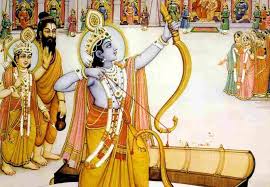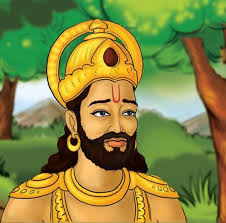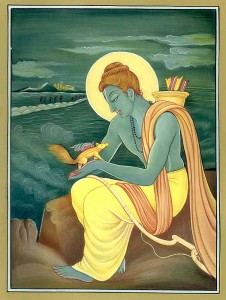Vishwamitra Muni’s Arrival
One day, the revered sage Vishwamitra Muni arrived at the court of King Dasarath. Though Dasarath was the ruler of the entire world, he humbly regarded himself as a servant of the great devotees of the Lord. This humility is a defining quality of a truly great person. Lord Sri Chaitanya Mahaprabhu beautifully illustrated this with the analogy that a tree laden with ripe fruits bends low; it does not stand tall to display its bounty. Similarly, a truly great soul bows down with humility and does not exalt his own qualities.
In the ancient Kshatriya culture, warriors were always humble and submissive to those who were learned in the science of the Absolute Truth. When Vishwamitra entered Dasarath’s court, the king offered him his own throne, washed his feet with his own hands, and served him with the utmost respect, along with his ministers, soldiers, and queens. In fact, Dasarath Maharaj was so devoted to serving Vishwamitra that he offered his entire kingdom to the sage. This attitude of humble service was the very foundation of the bliss and prosperity that pervaded the kingdom of Ayodhya.
When the formalities were over, Dasarath Maharaj asked Vishwamitra Muni, “How may I serve you?”
Ram and Laxman Accompany Vishwamitra Muni
Vishwamitra Muni requested something that Dasarath Maharaj did not expect. He explained that there were two terrible demons, Subahu and Maricha, who were disrupting his sacrifices in the forest. These demons were so powerful that no ordinary person could stop them. Vishwamitra said that he knew someone who could stop them—Dasarath’s son, Ram. The sage requested that Ram, along with his brother Laxman, accompany him to the forest to kill these demons.
Dasarath Maharaj was taken aback. Ram was still a young boy, just entering his teenage years. Although Dasarath knew that Ram was the all-powerful Supreme Personality of Godhead, his fatherly affection made him see Ram as his young, dependent son. Ram had been raised in the luxuries of the Ayodhya palace, and Dasarath couldn’t imagine him living in the dangerous forest, fighting fierce Rakshasas.
Dasarath offered himself to go in Ram’s place, promising to take an entire division of soldiers to defeat the demons. He asked Vishwamitra to explain more about the demons and their allegiance. When Vishwamitra revealed that they were servants of Ravana, Dasarath was filled with fear. Ravana was known throughout the universe as a powerful and fearsome Rakshasa who even the gods, including Indra, feared.
Despite his fears, Vishwamitra Muni insisted that Dasarath had given his word—a Kshatriya never goes back on his word of honor. At that moment, Vashista Muni, another sage, assured Dasarath that Vishwamitra himself could easily destroy the demons but had come to give Ram the opportunity to prove his valor. With this assurance, Dasarath, though with a heavy heart, surrendered to the request. He agreed to send his beloved sons, Ram and Laxman, with Vishwamitra.
Ram, full of divine wisdom and valor, joyfully accepted the task and, along with Laxman, went to the forest with Vishwamitra.
Ram Ends the Atrocities of Subahu and Maricha
Upon arriving at Vishwamitra’s hermitage, Ram and Laxman found the sages living in fear due to the terror of the demons. The demons would desecrate the sacrificial arenas with blood, corpses, and other abominable substances, terrorizing and killing the sages who resisted.
When Subahu and Maricha appeared in their monstrous forms to disrupt the sacrifices, Ram quickly took action. With one arrow, he killed Subahu, and with another, he struck Maricha in the chest, sending him flying 800 miles into the ocean. The sages were overjoyed and deeply grateful to Ram and Laxman for ending the terror of the demons. Though Ram and Laxman were divine beings, they humbly worshipped the sages, demonstrating the Lord’s greatest pastime—serving and giving pleasure to His devotees.
Ram and Laxman Serve Vishwamitra Muni
Vishwamitra Muni, pleased with Ram and Laxman, continued to instruct them during their time in the forest. Ram and Laxman, although divine, exemplified the importance of approaching a spiritual master, inquiring submissively, and rendering service. Wherever they traveled with Vishwamitra, they would collect wood, massage the sage’s legs, and perform other menial services. This was to set an example for the world on the necessity of following the spiritual injunctions to approach the spiritual master, inquire humbly, and render service.
Ram would not undertake any significant task without first seeking the blessings of Vishwamitra.
Ram, Laxman, and Vishwamitra Muni Visit Mithila
One day, Vishwamitra Muni informed Ram and Laxman that they would go on a pilgrimage to the holy city of Mithila, the kingdom of Maharaj Janak. When they arrived, Maharaj Janak, upon learning of Vishwamitra’s arrival, came out with his ministers and sages to greet them. As soon as Janak saw the divine beauty of Ram, he was struck with awe and inquired about him.
Vishwamitra Muni introduced Ram and Laxman as the sons of Dasarath. He then asked Maharaj Janak to explain the story of the great bow ceremony that was being held regularly in Mithila. Maharaj Janak narrated that during a battle between the demigods and demons, Lord Shiva had given him an invincible bow. This bow was so powerful that no one had ever been able to string it. Maharaj Janak had vowed that only the person who could string the bow would marry his daughter, Sita.
The First Meeting of Ram and Sita
Before the bow ceremony, Ram and Sita had already seen each other. The moment their eyes met, a deep, eternal love was awakened within them. Ramachandra, the Supreme Enjoyer, and Sita, the Supreme Devotee, were united in this divine love. Sita, who was born from the earth itself, was the very embodiment of beauty, charm, and divine qualities. She was the essence of devotion, and her existence was meant solely for the pleasure of Ram.
The Shastras explain that Radha-Krishna and Sita-Ram are the same Supreme Truth, divided into two forms for the purpose of enjoying eternal pleasure. Sita represents the Lord’s pleasure potency, and Ram is the Supreme Enjoyer. The meeting of Ram and Sita was the beginning of their divine union, a union that is the very essence of love and devotion.
Ram Bends the Bow and Strings It
As the ceremony began, Sita prayed fervently that Ram would be the one to lift the bow and win her hand in marriage. Knowing the desire of his beloved Sita, Ram turned to Vishwamitra Muni for his blessings. With the sage’s approval, Ram stepped forward towards the massive bow that no one had been able to lift. The citizens of Mithila were captivated by Ram’s divine beauty and prayed that he would be the one to marry Sita.
Ram approached the bow, and with effortless grace, he lifted it. As he pulled the string, the bow bent more and more until it cracked with a thunderous sound that echoed across the world. The force of the crack was so powerful that everyone in the assembly, except for Ram, Sita, Vishwamitra, Laxman, and Janak, fell unconscious. Even the demigods in the heavens were shaken.
When everyone regained consciousness, they saw Ram standing victoriously with the broken bow in his hands. The citizens of Mithila rejoiced, and Sita, with the blessings of her father, placed the garland of victory around Ram’s neck. The entire assembly erupted in cheers, chanting Ram’s holy name.
The actual site where Ram broke the bow still exists in Mithila, and it stands as a testament to this divine and historic event. The meeting of Sita and Ram and the breaking of the bow symbolize the union of the Supreme Lord with His eternal consort, the ultimate union of love and devotion.
Lessons to Be Learned
- Humility in Greatness: True greatness is marked by humility. Despite his immense power and authority, King Dasarath served Vishwamitra Muni with utmost humility, setting an example for all.
- Obedience to the Guru: Ram and Laxman’s devotion and service to Vishwamitra Muni highlight the importance of seeking guidance from a spiritual master and serving him with sincerity and devotion.
- The Power of Devotion: The divine love between Sita and Ram is the ultimate example of devotion. Sita’s prayer and Ram’s response demonstrate the power of true devotion in uniting the devotee with the Lord.
- Fulfillment of Divine Will: Ram’s breaking of the bow signifies the fulfillment of divine will. When the Lord decides to act, no force in the universe can stand in His way.
Prayer
O Supreme Lord Ram, the embodiment of truth and virtue, We bow before You, seeking Your grace and blessings.
May we, like Ram and Laxman, always seek guidance from the wise, And serve them with humility and devotion.
O Lord, may our hearts be pure and filled with devotion, As we strive to follow in the footsteps of Sita and Ram.
Hare Krishna, Hare Krishna, Krishna Krishna, Hare Hare, Hare Rama, Hare Rama, _R
4o
Continue generating
ChatGPT can make mistakes. Check important info.



